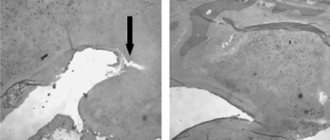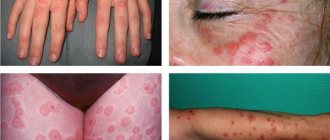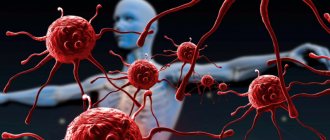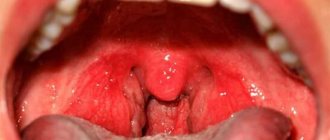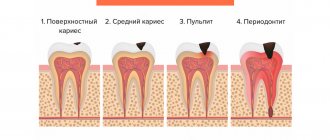Causes of mastoiditis
The cause of the disease is most often a complication of acute purulent otitis media or an exacerbation of chronic purulent otitis media. The infection spreads to the mastoid process for the following reasons: irrational therapy for acute otitis media, weakened immunity due to chronic diseases (diabetes mellitus, bronchitis, tuberculosis, rheumatoid arthritis). Mastoiditis can also develop when the cells of the mastoid process are injured.
Pathogenesis. Stages of disease development
The initial stage of the disease is called exudative. The development of chronic mastoiditis begins with inflammation of the mucous cells of the mastoid process with the simultaneous development of periostitis (inflammation of the periosteum) and the accumulation of exudate in the bone cavity. Swelling of the tissues, together with the accumulation of fluid, blocks the communication between the cells and the passage between the tympanic cavity and the mastoid process, thereby “clogging” the infectious process. Due to impaired ventilation in the cells, the air pressure in them drops, and under the influence of internal pressure, transudative fluid from the blood vessels begins to flow into the affected area. Mixed with pus, it quickly fills all the cells of the mastoid process. The first stage of the disease lasts about 10 days, in children – up to 6 days.
The second stage is proliferative-alterative. Purulent inflammation spreads to the bone walls and septa, contributing to the development of osteomyelitis. The partitions are destroyed, and one cavity is formed inside the bone tissue, filled with purulent contents. The disease takes on a typical or atypical form. The second is characterized by a sluggish course and mild symptoms.
Symptoms of mastoiditis
A typical set of symptoms for mastoiditis includes pain in the ear and postauricular area, headache (especially when moving the head), severe fever with a rise in body temperature up to 40 ° C, severe pain on palpation of the postauricular area, infiltration and hyperemia of the skin behind the auricle. Possible smoothness of the postauricular fold and protrusion of the auricle anteriorly, suppuration from the affected ear (not always), noise and decreased hearing in the affected ear, deterioration in general condition, and loss of appetite.
Differential diagnosis
In some cases, differential diagnosis is necessary to exclude diseases with similar symptoms. These are primarily diseases such as otitis externa, purulent parotid lymphadenitis, suppuration of congenital parotid cysts and fistulas. A differential diagnosis is also carried out with a boil of the external auditory canal - with it there is severe pain when touching the tragus and pulling back the auricle, and with mastoiditis these symptoms are absent, but there is a pronounced decrease in hearing, which is not typical for a boil. With a boil, the auditory canal is narrowed in the membranous-cartilaginous section, with mastoiditis - in the bone section.
Classification
The occurrence of infection varies:
- primary mastoiditis, with initial entry of the inflammatory agent into the mastoid cavity,
- secondary mastoiditis, which occurs as a complication of inflammatory processes in the body.
Secondary mastoiditis can occur:
- as a result of otitis media, it is called otogenic,
- as a result of head injuries,
- as a focus during sepsis (septicopyemic focus).
Along the way, mastoiditis can be:
- typical, with all the classic symptoms present,
- atypical or latent, sluggish inflammatory process without pronounced symptoms.
Methods for diagnosing mastoiditis
Palpation and percussion of the mastoid process are performed, radiography of the temporal bones is performed, as well as MRI or CT.
Laboratory diagnostics
Laboratory diagnostics for mastoiditis includes a general blood test, a biochemical blood test, bacteriological culture from the ear canal and from the mastoid cavity with an antibiotic sensitivity test.
Instrumental diagnostics
Otoscopy, audiometry, and tuning fork examination allow us to determine the degree of hearing loss in a patient with mastoiditis. Paracentesis of the tympanic membrane is performed for diagnostic purposes (performed for mastoiditis that has developed against the background of acute otitis media).
Sign up for diagnostics To accurately diagnose the disease, make an appointment with specialists from the Family Doctor network.
Complications
In advanced cases, in the absence of timely medical care, the acute development of one- or two-sided mastoiditis can lead to:
- neuritis of the facial nerve;
- thrombophlebitis;
- purulent mediastinitis, when pus penetrates into the space of the cervical spine;
- brain abscess, encephalitis;
- damage to the eyeball, development of phlegmon or endophthalmitis;
- sepsis, retropharyngeal process.
When to see a doctor
The first signs of otitis or mastoiditis require timely examination by a specialist, qualified treatment and constant monitoring. You should stop trying to self-medicate and contact an otolaryngologist for additional diagnostics and development of a treatment course.
Treatment methods for mastoiditis
Treatment for mastoiditis is aimed at
- stopping the spread of the inflammatory process through the system of air cavities of the middle ear and beyond the temporal bone;
- alleviation of symptoms;
- prevention of the development of persistent hearing impairment and the formation of a purulent focus as the cause of subsequent relapse.
All patients with mastoiditis, regardless of the etiology of the disease and the stage of the inflammatory process, are required to be hospitalized in the otolaryngology department.
At the initial stage of mastoiditis, treatment is the same as for acute otitis media: physiotherapy (UHF therapy, microwave, etc.), intramuscular or intravenous antibacterial therapy. Additionally, antihistamines, anti-inflammatory, detoxification, and immunocorrective drugs are used. An important step is to create an outflow of pus from the ear (for which paracentesis of the eardrum is performed).
Mastoiditis in the exudative stage can be treated conservatively. Mastoiditis of the proliferative-alterative stage requires surgical opening of the suppurating cells of the mastoid process and removal of the pathologically changed bone, elimination of pus and postoperative drainage.
With timely and rational treatment, in most cases the prognosis is favorable. With late diagnosis and unfavorable course of the disease, complications may develop, such as purulent labyrinthitis, damage to the facial nerve (manifested by facial asymmetry: the corner of the mouth or eye goes down, the eyelid closes poorly, the face looks like a mask), intracerebral complications (meningitis, encephalitis); possible ophthalmological complications (endophalmitis, orbital phlegmon), sepsis.
Prevention of mastoiditis
Prevention of otogenic mastoiditis comes down to correct treatment of nasopharyngeal diseases, rapid elimination of infectious foci, timely diagnosis of inflammatory lesions of the middle ear, and adequate treatment of otitis media.
Make an appointment Do not self-medicate. Contact our specialists who will correctly diagnose and prescribe treatment.
Rate how useful the material was
thank you for rating
Causes and course of the disease
Among the causative agents of acute mastoiditis, the main causative agents of the disease are staphylococci, as well as polymorphic flora, including Pseudomonas aeruginosa, streptococcal flora and Proteus.
The same microorganisms also cause acute purulent inflammation of the middle ear. Among the causes of mastoiditis, in addition to the patient’s weak immunity and unfavorable predisposing factors, it should be noted the important role of factors such as the patient’s age, the structure (type of structure) of the mastoid process, as well as previously used methods of treating acute otitis media, if the disease began with acute otitis. In children, acute mastoiditis develops quickly, in older people it develops much more slowly.
From a pathomorphological point of view, typical mastoiditis is characterized by inflammation of the cells of the mucoperiosteum (integral with the periosteum) of the mastoid process. In this case, mucoid swelling (a reversible phase of tissue disorganization) of the mucous membrane, circulatory disorders and small cell infiltration are observed.
Subsequently, the cells are filled with purulent exudate. Then the bone tissue of the bridges between the cells is involved in the inflammatory process. Then their purulent melting occurs, and they merge with each other, forming a bone cavity in which creamy pus is located.
If bone melting is directed to the outer parts of the mastoid process or zygomatic cells, then pus breaks through under the periosteum, forming a subperiosteal abscess (localized under the periosteum).
In the case when the melting is directed to the middle or posterior cranial fossa, the development of various intracranial complications is possible.
Make an appointment right now!
Call us by phone or use the feedback form
Sign up
There are primary and secondary forms of mastoiditis. The primary one includes the rare occurrence of mastoiditis - independent diseases that develop without acute inflammation of the middle ear. The secondary form of mastoiditis is:
- Typical, when acute mastoiditis develops against the background of acute purulent inflammation of the middle ear, including apical-cervical (Betsoldovsky) mastoiditis;
- Atypical, when acute mastoiditis occurs with acute inflammation of the middle ear without perforation of the eardrum.
Prevention
Preventive measures for mastoiditis include:
- Moderate physical activity
- Elimination of foci of chronic infection in the body,
- Immune stimulation,
- Proper, healthy eating,
- Full sleep
- Maintaining a healthy lifestyle,
- Prevention of diseases complicated by mastoiditis - otitis media, tuberculosis, diabetes mellitus, rhinitis, sinusitis.
- Timely diagnosis and treatment of inflammatory diseases of the middle ear.
Features of the disease in children
Since the mastoid process is underdeveloped in infants, pus in otitis media penetrates only into the cave of the temporal bone - the antrum and leads to the development of purulent anthritis. Otitis and anthritis are diagnosed in children with reduced body resistance, premature and rickety children.
A distinctive feature of the pathology in children is the rapid development of a subperiosteal abscess, often without bone destruction.
Clinical symptoms of mastoiditis in children:
- Fever,
- Cry,
- Moodiness,
- Restless sleep
- Poor appetite
- Symptoms of meningism,
- Copious purulent discharge.
Otoscopic manifestations: bulging of the eardrum, change in its color, swelling, the appearance of a pulsating reflex at the site of perforation.
Total information
The mastoid process is the site of attachment of the muscles that turn the head laterally. It is located behind the auricle, slightly downwards and sticks out slightly if you feel it. Inside, the mastoid process is filled with bony partitions in the form of a honeycomb, but it acquires this structure as the body grows, by about six years.
It is at this age that typical manifestations of destructive processes occur in the periosteum and bone tissue of the appendix. The mastoid process is separated from the cranial cavity by a thin bone plate, which makes the inflammatory process in its area extremely dangerous.
